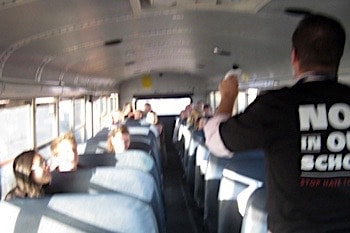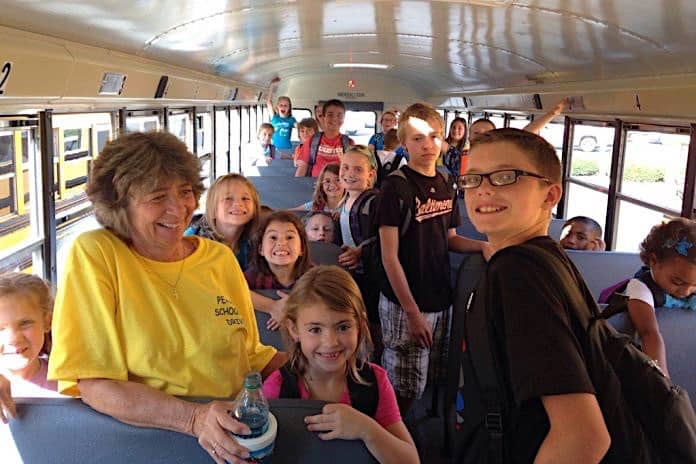Though headlines have blared about violence on the yellow bus just weeks into the new school year, school officials affirm that anti-bullying programs are making a difference for students across the nation.
School districts in Minnesota reported seeing positive results from PRIDE and Olweus bullying prevention programs that were implemented within the prior school year, and last spring the state passed a new anti-bullying law that calls on public schools to follow suit.
Stories abound on the number of schools that have adopted the Peaceful School Bus program developed by New York’s Guilderland Central School District and offered by Hazelden Publishing. This whole-school program is designed to decrease inappropriate behavior on buses while creating a climate of respect and cooperation.
Ohio school psychologists Amy Van Strien and Allison Wnorski gave a presentation on their success with the PSB program in Loveland City Schools at the National Association of School Psychologists convention in Washington, D.C., last February.
Former colleagues at Loveland, they implemented the program there after 49 bullying and harassment incidents were reported in the 2010-2011 school year. “We headed up the anti-bullying campaign for the whole district, who did some surveys with us. We found parents and students were identifying bullying happening on the school bus more often than the classroom,” she recalled.
Kids usually don’t tell adults about bullying, and kids are masterful at knowing when adults aren’t looking, explained Van Strien, who spent 20 years at Loveland before bringing her expertise to Indian Hill School District in 2003.
“The core theory is the more you can build community on the bus, the less likely the students are to bully each other. The idea is to make connections so that kids feel more responsible for each other — to get them to stand up for each other,” she said.
In the early years, Wnorski led school bus group meetings for the younger elementary students, while Van Strien focused on fifth-grade and middle school students.
“The first- through eighth-graders shared with us what they liked about the program,” she said. “They gave us specifics about changes they saw on the bus, saying people were friendlier and they liked knowing more people on the bus.”
The counselors also empowered students to launch an anti-bullying video project, “My Choice, My Voice” that grew into a district-wide campaign— and drew media attention.
“The first year we followed what the (PSB) book said and the second year we modified it some more,” Van Strien continued. “The bus drivers really appreciated having a connection to the school … Some of the strategies really worked for them.”
And they are still working, according to Wnoroski, who told STN that all Loveland school bus drivers utilize bus rules from this program.
“Our program, Peaceful School Bus, went well last year. We will continue using our modified version of (it) … we have definitely seen a difference in bus discipline referrals following the use of this program,” she said, pointing to a 65-percent drop in the third year of implementation. “We also saw a big decrease in repeat offenders following implementation of the program.”
This year they changed up the program by using a combination of in-school bus meetings with all the student riders and bus check-ins where staff would teach a mini-lesson onboard.
Added Wnoroski: “Teachers also do random check-ins on their buses occasionally throughout the school year to increase staff presence on the bus and reinforce the idea that teachers and other school staff care what happens on the bus.”
Peace, One Bus at a Time
Rita Sterner-Hine, principal of Summitview Elementary School in Pennsylvania’s Waynesboro Area School District, kicked off the PSB program Aug. 18 and reported high levels of enthusiasm among students as well as bus drivers. The drivers are not employed by the district, which uses three contractors for different parts of town. But they sure look like a team in their new, yellow “Peaceful School Bus” T-shirts.
As principal, she noticed last year that the majority of discipline referrals arose from school bus incidents. So she worked with her school counselor to create a survey for bus drivers to pinpoint the most problematic behaviors on the bus and find solutions.
The 30-plus bus drivers who responded consistently said noise was their biggest problem, as well as students leaving their seats, Sterner-Hine noted. And these results matched what elementary students reported in focus groups they held at school. Children reported that buses were too loud and too crowded, students did not stay seated and there was bullying as well as inappropriate language.
“Bullying can be very subtle,” she explained, “and PSB talks about how drivers catch the overt behavior like kids are jumping over a seat or throwing something … but they can’t necessarily catch the verbal abuse or even the physical abuse unless it’s reported.”
This is why it is essential to educate students at a young age so they understand the school bus is an extension of their classroom, Sterner-Hine stressed.
“I tell students that they need to tell their parents when something is happening on the school bus that is making them feel unsafe, but the first person they should tell is the bus driver because that is the person who can most directly improve the situation,” she added. “I feel that, as a building principal, I have more control over my building than I do a school bus, but the school bus is an extension of my school. So it was like finding a program to provide an added layer of security.”
 An Anti-Bullying Bus
An Anti-Bullying Bus
Sterner-Hine shared that the Waynesboro district received a grant that allowed them to implement the anti-bullying initiative. “Moving forward, we’re going to have additional meetings, and invite drivers if they’re available to student meetings as well. A key component of the program is for students to understand that drivers are an extension of our school and they are important members of it,” she continued.
The Jordan School District also relied on grant funding to launch a unique program that sends a busload of middle-school student “ambassadors” (pictured, at left) to elementary schools, where they teach the three anti-bullying themes: Empathy, celebrating diversity and respect.
School counselor Julie Scherzinger told STN her principal approached her three years ago about developing an anti-bullying program, so she and her team developed a systematic approach with a clear message: “Not In Our Schools.” Their goal was to inspire kids to think about the impact of bullying and what they can do to stop it.
Scherzinger said the number of student ambassadors has grown each year since the “anti-bullying bus” hit the road: from 23 to 50 and then 75 for the 2013-14 school year.
“We have ambassadors also help with a text line that we implemented for reporting bullying,” she said. “In our lessons, we tell kids there is a phone they can text to that goes into the counseling center. So, if they see things they don’t like that make them feel unsafe or uncomfortable, they can text it in and it’s anonymous. We want them to own their school.”
Scherzinger added that students also use the text line to report when classmates are doing something good, such as standing up for someone. The counselors reward these students and invite them to become ambassadors, while also accepting nominations from elementary school teachers.
 “We just wanted to change the climate of our school; we know climate is tied to everything from test scores to dropout rates,” she explained. “Kids have the most power. They think we adults have all of it. But we teach them they have the power and they can change the climate. I tell them it’s your hallway, your school bus, so what can we do?”
“We just wanted to change the climate of our school; we know climate is tied to everything from test scores to dropout rates,” she explained. “Kids have the most power. They think we adults have all of it. But we teach them they have the power and they can change the climate. I tell them it’s your hallway, your school bus, so what can we do?”
She said every school receives video training throughout the year that is broadcast in classrooms via Apple TV. Now, she hopes to bring this training curriculum to the district’s transportation department.
“This year maybe we’ll do transportation and use buses as an avenue to get our message out even more,” Scherzinger continued. “We make sure there are ambassadors on every bus … It takes a special group of kids who will do this.”


















